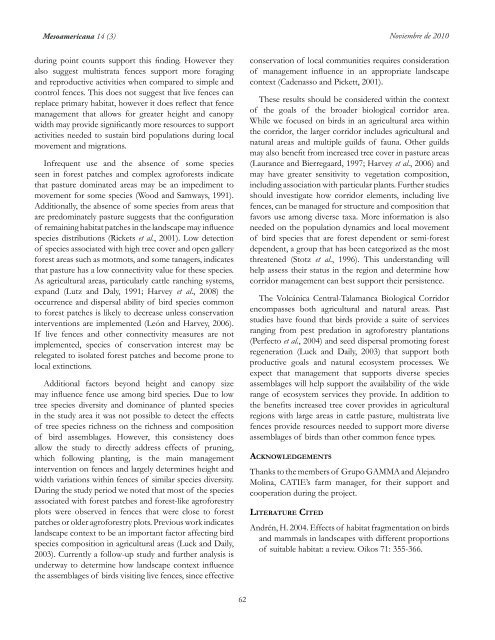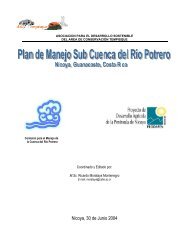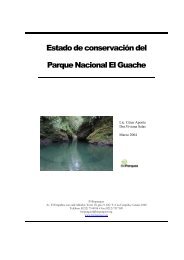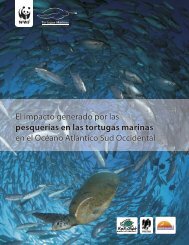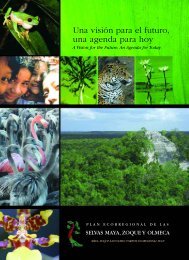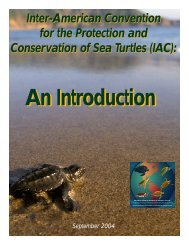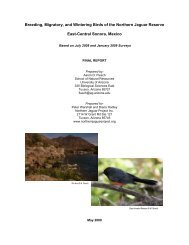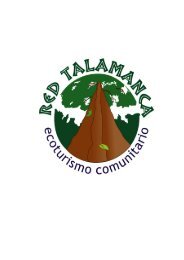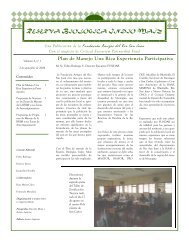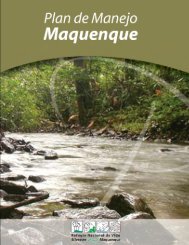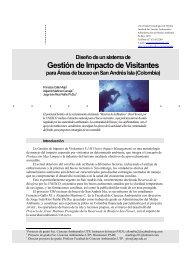Volumen 14(3) Noviembre de 2010 - Eco-Index
Volumen 14(3) Noviembre de 2010 - Eco-Index
Volumen 14(3) Noviembre de 2010 - Eco-Index
You also want an ePaper? Increase the reach of your titles
YUMPU automatically turns print PDFs into web optimized ePapers that Google loves.
Mesoamericana <strong>14</strong> (3) <strong>Noviembre</strong> <strong>de</strong> <strong>2010</strong>during point counts support this finding. However theyalso suggest multistrata fences support more foragingand reproductive activities when compared to simple andcontrol fences. This does not suggest that live fences canreplace primary habitat, however it does reflect that fencemanagement that allows for greater height and canopywidth may provi<strong>de</strong> significantly more resources to supportactivities nee<strong>de</strong>d to sustain bird populations during localmovement and migrations.Infrequent use and the absence of some speciesseen in forest patches and complex agroforests indicatethat pasture dominated areas may be an impediment tomovement for some species (Wood and Samways, 1991).Additionally, the absence of some species from areas thatare predominately pasture suggests that the configurationof remaining habitat patches in the landscape may influencespecies distributions (Rickets et al., 2001). Low <strong>de</strong>tectionof species associated with high tree cover and open galleryforest areas such as motmots, and some tanagers, indicatesthat pasture has a low connectivity value for these species.As agricultural areas, particularly cattle ranching systems,expand (Lutz and Daly, 1991; Harvey et al., 2008) theoccurrence and dispersal ability of bird species commonto forest patches is likely to <strong>de</strong>crease unless conservationinterventions are implemented (León and Harvey, 2006).If live fences and other connectivity measures are notimplemented, species of conservation interest may berelegated to isolated forest patches and become prone tolocal extinctions.Additional factors beyond height and canopy sizemay influence fence use among bird species. Due to lowtree species diversity and dominance of planted speciesin the study area it was not possible to <strong>de</strong>tect the effectsof tree species richness on the richness and compositionof bird assemblages. However, this consistency doesallow the study to directly address effects of pruning,which following planting, is the main managementintervention on fences and largely <strong>de</strong>termines height andwidth variations within fences of similar species diversity.During the study period we noted that most of the speciesassociated with forest patches and forest-like agroforestryplots were observed in fences that were close to forestpatches or ol<strong>de</strong>r agroforestry plots. Previous work indicateslandscape context to be an important factor affecting birdspecies composition in agricultural areas (Luck and Daily,2003). Currently a follow-up study and further analysis isun<strong>de</strong>rway to <strong>de</strong>termine how landscape context influencethe assemblages of birds visiting live fences, since effectiveconservation of local communities requires consi<strong>de</strong>rationof management influence in an appropriate landscapecontext (Ca<strong>de</strong>nasso and Pickett, 2001).These results should be consi<strong>de</strong>red within the contextof the goals of the broa<strong>de</strong>r biological corridor area.While we focused on birds in an agricultural area withinthe corridor, the larger corridor inclu<strong>de</strong>s agricultural andnatural areas and multiple guilds of fauna. Other guildsmay also benefit from increased tree cover in pasture areas(Laurance and Bierregaard, 1997; Harvey et al., 2006) andmay have greater sensitivity to vegetation composition,including association with particular plants. Further studiesshould investigate how corridor elements, including livefences, can be managed for structure and composition thatfavors use among diverse taxa. More information is alsonee<strong>de</strong>d on the population dynamics and local movementof bird species that are forest <strong>de</strong>pen<strong>de</strong>nt or semi-forest<strong>de</strong>pen<strong>de</strong>nt, a group that has been categorized as the mostthreatened (Stotz et al., 1996). This un<strong>de</strong>rstanding willhelp assess their status in the region and <strong>de</strong>termine howcorridor management can best support their persistence.The Volcánica Central-Talamanca Biological Corridorencompasses both agricultural and natural areas. Paststudies have found that birds provi<strong>de</strong> a suite of servicesranging from pest predation in agroforestry plantations(Perfecto et al., 2004) and seed dispersal promoting forestregeneration (Luck and Daily, 2003) that support bothproductive goals and natural ecosystem processes. Weexpect that management that supports diverse speciesassemblages will help support the availability of the wi<strong>de</strong>range of ecosystem services they provi<strong>de</strong>. In addition tothe benefits increased tree cover provi<strong>de</strong>s in agriculturalregions with large areas in cattle pasture, multistrata livefences provi<strong>de</strong> resources nee<strong>de</strong>d to support more diverseassemblages of birds than other common fence types.Ac k n o w l e d g e m e n t sThanks to the members of Grupo GAMMA and AlejandroMolina, CATIE’s farm manager, for their support andcooperation during the project.Li t e r a t u r e Ci t e dAndrén, H. 2004. Effects of habitat fragmentation on birdsand mammals in landscapes with different proportionsof suitable habitat: a review. Oikos 71: 355-366.62


